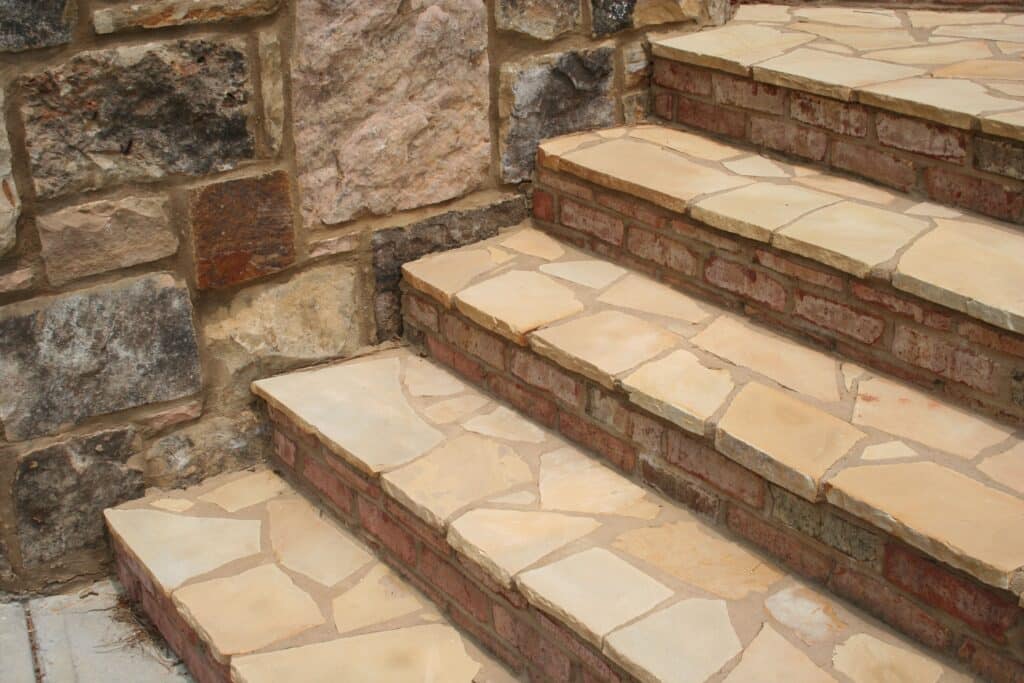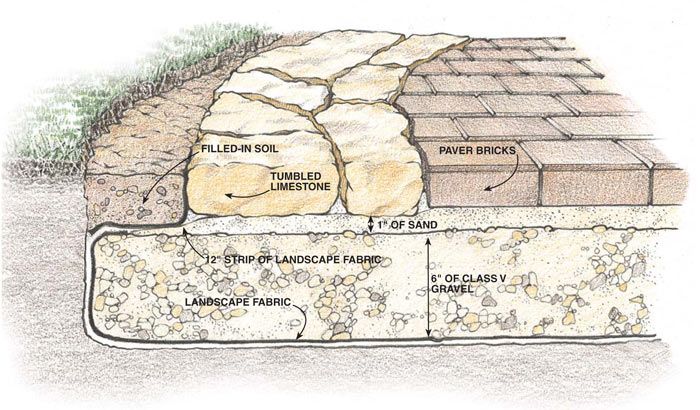
Flagstone huwa wieħed mill-aktar ġebel ċatt ġeneriku użat. Huwa meqjus bħala l-aħjar trasportatur sostenibbli ta 'awtentiċità fid-disinn tal-pajsaġġ tiegħek.
Raġuni konvinċenti wara dan hija meta tuża dawn il-flat ġebel, inti se toħloq tħossok magħmul bl-idejn għall-tarzna tiegħek li tidher ukoll prontezza. Għalkemm hemm ħafna varjazzjoni ta 'ġebel moderni u rustic maqtugħin, tista' toħroġ it-togħma u l-istil individwali tiegħek.
In this blog, you will first get to know the origins of this flagstone and learn about its creation. Afterward, you’ll learn about the different types and the best practices for using them. At length, you’ll gain valuable knowledge in the art and science of installing this material.
Flagstone is a generic term for many different types of rock. In the beginning, a stonemason chisels or strikes larger stones. And as a result, it breaks up into thick, flat sheets. Next, these thinner sheets are then broken up into flagstone-sized pieces. There are abundant varieties of rock that masons cut and then shape into flagstones.
Inizjalment, il-blat l-aktar artab u l-eħfef biex jissarraf fil-forma huma blat sedimentarju, inklużi varjetajiet bħal ġebel ramli, shale u ġebel tal-ġir.
Sekondarjament, varjetajiet aktar diffiċli jinkludu blat igneous bħal granit jew bażalt. Fl-aħħarnett, it-tipi l-aktar ħorox jappartjenu għall-blat metamorfiku, bħal kwarżit u wkoll irħam.
Hemm żewġ tipi ewlenin fid-domanda ta ' Flagstones: patio and select. Comparatively, Patio pieces type of Flagstone is smaller, ranging from 12” to 18” and thicker. And are most often used for stepping stones, outdoor pathways, or patios. Due to their smaller size, they are typically palletized lying down, preventing breakage during shipment. Contrarily, select flagstone, known as “standup,” comes in large, thin slabs of 18” to 36”. Due to their large size, they are usually palletized vertically. Flagstones generally make the formation of many shapes and sizes, including rectangular and square. Nevertheless, they are also available in more natural, jagged varieties.

For more than hundreds of thousands of years, Flagstone has been used in various types of formation. Earlier in the 1900s, people saw it as an improvement over cobblestone, and it’s easy to see why. Whereas stonemasons can chisel it at ease by hand into a very flat surface, it is a simple way to create a flat paving surface. Its notable usages as countertop material or even as a paving substrate and as a walkway or roadway. People even use them as roofing and siding. Flagstone patios and Stepping stones are the most common applications of flagstones.

Normalment nużaw ir-ramel bħala materjal bażi għall-ġebel. L-ewwelnett, Sand huwa pjuttost faċli biex jiġi installat u joffri vantaġġ kbir tad-drenaġġ. Barra minn hekk, huma wkoll se jgħinu biex jipprevjenu l-ħaxix ħażin u t-tkabbir tal-pjanti bejn il-ġebel tiegħek bħala riżultat. Madankollu, għal installazzjoni aktar permanenti, uża siment. B'bażi tar-ramel, ser ikollok bżonn ta 'ġebel eħxen. Il-mehrież jippermettilek ukoll li tuża ġebel irqaq peress li l-bażi tas-siment tgħin biex issaħħaħ il-wiċċ.

L-aħjar ħaġa dwar din il-ġebla naturali hija li tista 'tissawwarha biex toħloq ħafna mudelli differenti u uniċi! L-istess, l-uniku limitu huwa l-immaġinazzjoni tiegħek ma 'dan il-materjal. Biex tiddekodifika l-viżwalizzazzjoni tiegħek, fir-realtà, kull ma trid tagħmel hu li torbot il-pajsaġġ tiegħek flimkien. Dan jagħmel sens li jekk trid dehra moderna u nadifa, trid tiżgura li żżomm ma 'mudell aktar riġidu u ripetut. Min-naħa l-oħra, tista 'tmur għal daqsijiet irregolari u forom każwali għal dehra rustic u naturali.

Tista 'tħobb il-ġebel għal ħafna raġunijiet, inklużi, Ġebel tal-bandiera which are naturally flat, and it’s easy to use in so many different projects.
However, because flagstone is more of a generic term for many sedimentary rocks, it’s easy to misunderstand and underappreciate.
Hawn huma xi affarijiet li għandek tkun taf dwarhom:
Flagstone’s one of the beneficial advantages is that it’s relatively flat when mined, making it ideal in so many landscaping projects.
Second, it’s naturally non-slip. Whenever you are all set to starting a project where people will need to walk, a non-slip surface is essential for safety. Next, it’s strong and stable. When installed properly, it won’t break or crack.
Ġeneralment, tista 'ssib diversi spettru jew lwien ta' Ġebel tal-bandiera u tagħmel użu minn xi sfumaturi. Għalkemm ħafna għandhom sfumaturi griż jew kannella bħall-biċċa l-kbira tal-blat, il-ħafna sfumaturi jista 'jkollhom roża, ħodor, blu, deheb, u anke qrib abjad.
Ifisser li dejjem tista’ ssib u tagħżel ġebla li tista’ tikkumplimentaha jew tikkuntrastaha, liema tkun l-għan tiegħek, irrispettivament minn liema kuluri diġà qed jiġu applikati madwar id-dar tiegħek.
B'mod partikolari, tista 'tikseb taħlita faċli ta' ġebel b'ħafna kuluri u toħloq patio jew passaġġ wieħed-of-a-kin ukoll.
Il-flessibbiltà tal-installazzjoni tista' titqies ukoll bħala wieħed mill-ħafna benefiċċji tagħha. Biex tpoġġi patio, tista 'tixtieq tikkunsidra li tinstallah b'mehrież bejn il-ġebel. Dan ċertament jagħti lill-patio tiegħek tħossok kompletament livell u solidu, ideali għal siġġijiet u mwejjed.
Suppose you’re planning to construct a walkway across your lawn. You can install large stones directly on your dirt and install mulch or allow the grass to grow around it.
As an alternate, you can also create a walking path with gravel between the stones. It’s also a great option for building stairs. Nevertheless, you would want to use cement to ensure safety and stability.
From our long-entailed informative blog, we hope we have provided you a clear conception of how, no matter what project you’re planning, there are ways to incorporate this beautiful stone.